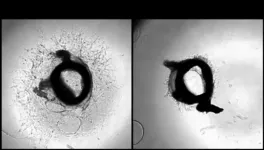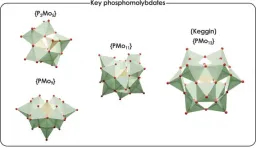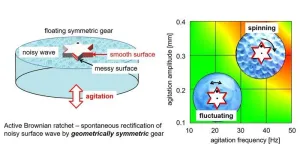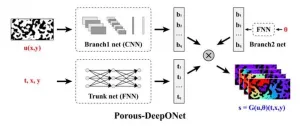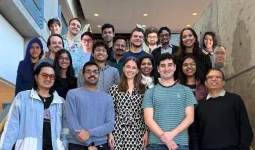(Press-News.org) A multidisciplinary team of scientists led by Carlo Ballatore, Ph.D., at University of California San Diego and Kurt Brunden, Ph.D., at the University of Pennsylvania has been awarded a $6.9 million grant from the National Institute on Aging (NIA) to prepare a potential disease-modifying Alzheimer’s treatment for future clinical trials. In a recently published study about the new compound, called CNDR-51997, the team found it was effective in restoring brain health in mouse models of Alzheimer's disease. CNDR-51997 was identified through a joint drug discovery program at Penn and UC San Diego that was supported by grants from the NIA.
The new grant will help the researchers demonstrate the drug’s safety in formal studies required by the U.S. Food and Drug Administration (FDA) prior to the initiation of human testing. By the end of the three-year grant period, the researchers hope to submit an Investigational New Drug (IND) application to the FDA that, if approved, would allow for Phase 1 clinical studies.
"Alzheimer’s is a devastating disease with very few treatment options, so we are eager to advance CNDR-51997 through the drug development process," said Ballatore, a professor at UC San Diego Skaggs School of Pharmacy and Pharmaceutical Sciences. "This compound has been designed to combat tau-mediated neurodegeneration and our preclinical data suggest that it could be beneficial for the treatment of Alzheimer's and related dementias."
Alzheimer’s disease is characterized by abnormal deposits of two types of protein in the brain: amyloid beta (Aβ) and tau. The only currently available disease-modifying treatments for Alzheimer’s, lecanemab (Leqembi™) and donanemab (Kisunla™), target Aβ deposits in the brain. Notably, there are currently no approved therapies that target pathological tau. In mice, the researchers found that CNDR-51997 was able to reduce both Aβ plaques and tau pathology in the brain.
In addition to Alzheimer’s there are several other diseases characterized by tau pathology, such as frontotemporal lobar degeneration, progressive supranuclear palsy, corticobasal degeneration, Pick’s disease, traumatic brain injury and chronic traumatic encephalopathy (CTE). The researchers believe that their compound could not only be a future treatment for Alzheimer’s, but also for these other related diseases, collectively called tauopathies.
“Our findings that CNDR-51997 reduces both Aβ plaques and tau inclusions in mouse models suggest that the compound holds considerable promise for Alzheimer’s disease. However, there is also a great unmet need for disease-modifying drugs for the other tauopathies,” said Brunden, a research professor in the Perelman School of Medicine and director of drug discovery at Penn’s Center for Neurodegenerative Disease Research. “The potential of CNDR-51997 to address tau-related diseases beyond Alzheimer's is another important aspect of its therapeutic promise.”
One of the functions of tau is to stabilize microtubules, dynamic tube-like structures that help give cells their shape. In neurons, microtubules play an important role in axonal transport, a process in which proteins and other cellular constituents are distributed to different parts of the long axonal extensions that are involved in brain function.
In Alzheimer’s disease and other tauopathies, tau becomes detached from microtubules, which causes them to become disorganized. This leads to axonal transport deficits and neuronal loss. In preclinical studies, the new compound CNDR-51997 was able to correct these imbalances, ultimately reducing both Aβ and tau pathologies.
“This is a unique compound with desirable properties, and Dr. Brunden and I are grateful to the NIA for their continued support and the opportunity to develop this compound further through IND-enabling studies, which if successful, will lead to an IND submission,” said Ballatore.
# # #
END
NIH awards $6.9 million to advance potential Alzheimer’s disease treatment
UC San Diego and University of Pennsylvania scientists will develop a tau-targeting drug candidate through IND-enabling studies
2024-08-20
ELSE PRESS RELEASES FROM THIS DATE:
iSN04: A novel nucleic acid drug for the treatment of vascular diseases
2024-08-20
Atherosclerosis, a major cause of mortality worldwide, involves an overgrowth of vascular smooth muscle cells in the blood vessels, constraining blood flow and potentially causing cardiovascular diseases. Against this backdrop, researchers from Shinshu University recently developed a DNA aptamer called iSN04 that targets and counteracts with the protein nucleolin in smooth muscle cells. This anti-nucleolin aptamer helps maintain smooth muscle cells in a differentiated state, offering new treatment potential for atherosclerosis and other vascular ...
New computational methodology to predict the complex formation of interesting nanostructures
2024-08-20
Researchers from the group of Prof. Carles Bo, at the Institute of Chemical Research of Catalonia (ICIQ-CERCA), have described a computational methodology that simulates complex processes involving different chemical species and diverse conditions. These processes lead to the formation of nanostructures called polyoxometalates (POMs), with important applications in catalysis, energy storage, biology and medicine.
"Our group has recently developed unique methods to study the chemistry of polyoxometalates in solution, their speciation and formation ...
Novel ratchet with geometrically symmetric gear driven by asymmetric surface wettability
2024-08-20
The ratchet mechanism is a fascinating energy-conversion system that converts disorderly or random motion into orderly, directed movement through a process known as spontaneous rectification. It is a critical component of mechanical systems, typically consisting of a gear and a pawl, which restricts the movement of the gear in one direction. In biological systems, the concept of a Brownian ratchet has been proposed to help understand the mechanism of molecular motors, where chemical reactions rectify the random thermal motion of molecules.
According to the second law of thermodynamics, uniform thermal ...
Porous-DeepONet: A deep learning framework for efficiently solving reaction-transport equations in porous media
2024-08-20
Porous media play a critical role in various industrial fields due to their complex pore networks and considerable specific surface areas. The transport and reaction phenomena within porous media are key factors influencing fundamental parameters such as energy storage efficiency, catalytic performance, and adsorption rates. To accurately describe these complex transport and reaction processes, solving parameterized partial differential equations (PDEs) is necessary. However, due to the complex structure of porous media, traditional methods, such as the finite element method ...
Association for Molecular Pathology files lawsuit against FDA to challenge final rule on regulation for laboratory developed testing procedures
2024-08-20
ROCKVILLE, Md. – August 19, 2024 – The Association for Molecular Pathology (AMP), the premier global molecular diagnostic professional society, and world-renowned pathologist Michael Laposata, MD, PhD, today announced the filing of a lawsuit challenging the recent U.S. Food and Drug Administration (FDA) Rule that regulates laboratory developed test (LDT) procedures as medical devices under the Federal Food, Drug, and Cosmetic Act. The lawsuit was filed in the U.S. District Court for the Southern District of Texas against the FDA; Robert M. Califf, MD, in his official capacity as Commissioner of Food and Drugs; the U.S. Department of Health ...
Using AI to find the polymers of the future
2024-08-20
Nylon, Teflon, Kevlar. These are just a few familiar polymers — large-molecule chemical compounds — that have changed the world. From Teflon-coated frying pans to 3D printing, polymers are vital to creating the systems that make the world function better.
Finding the next groundbreaking polymer is always a challenge, but now Georgia Tech researchers are using artificial intelligence (AI) to shape and transform the future of the field. Rampi Ramprasad’s group develops and adapts ...
Salk Professor Rusty Gage awarded 2024 Taylor International Prize in Medicine
2024-08-20
LA JOLLA (August 14, 2024)—Professor Rusty Gage has been awarded the 2024 J. Allyn Taylor International Prize in Medicine by the Schulich School of Medicine & Dentistry and the Robarts Research Institute at Western University. One of the most prestigious medical research awards in Canada, the Taylor Prize recognizes scientists for transformative, career-defining work in basic sciences, translational research, and medical innovations.
This year’s prize specifically honors a research leader in aging-related medical science and research—a long-term focus of Gage and his lab. Gage will receive $50,000 and be celebrated at a Robarts Research ...
Heart data unlocks sleep secrets
2024-08-20
We know that quality sleep is as essential to survival as food and water. Yet, despite spending a third of our lives in slumber, it largely remains a scientific mystery.
Not that experts haven’t tried.
Sleep analysis, also known as polysomnography, is used to diagnose sleep disorders by recording multiple types of data, including brain (electroencephalogram or EEG) and heart (electrocardiogram or ECG). Typically, patients are hooked up to dozens of sensors and wires in a clinic, tracking brain, ...
Development of a model capable of predicting the cycle lives of high-energy-density lithium-metal batteries
2024-08-20
1. NIMS and SoftBank Corp. have jointly developed a model capable of predicting the cycle lives of high-energy-density lithium-metal batteries by applying machine learning methods to battery performance data. The model proved able to accurately estimate batteries’ longevity by analyzing their charge, discharge and voltage relaxation process data without relying on any assumption about specific battery degradation mechanisms. The technique is expected to be useful in improving the safety and reliability of devices powered by lithium-metal batteries.
2. Lithium-metal ...
UVA Engineering Professor’s $600,000 grant set to innovate pediatric brain tumor treatment
2024-08-19
Natasha Sheybani, assistant professor of biomedical engineering at the University of Virginia School of Engineering, will collaborate with researchers at Children’s National Hospital to study the combination of two therapies for pediatric brain cancer.
High-risk brain tumors in children often don’t respond well to existing chemotherapy and radiation treatments, but Sheybani and her collaborators hope their fusion of therapies will offer a better option.
Over the two-year project, researchers ...
LAST 30 PRESS RELEASES:
Longest observation of an active solar region
Why nail-biting, procrastination and other self-sabotaging behaviors are rooted in survival instincts
Regional variations in mechanical properties of porcine leptomeninges
Artificial empathy in therapy and healthcare: advancements in interpersonal interaction technologies
Why some brains switch gears more efficiently than others
UVA’s Jundong Li wins ICDM’S 2025 Tao Li Award for data mining, machine learning
UVA’s low-power, high-performance computer power player Mircea Stan earns National Academy of Inventors fellowship
Not playing by the rules: USU researcher explores filamentous algae dynamics in rivers
Do our body clocks influence our risk of dementia?
Anthropologists offer new evidence of bipedalism in long-debated fossil discovery
Safer receipt paper from wood
Dosage-sensitive genes suggest no whole-genome duplications in ancestral angiosperm
First ancient human herpesvirus genomes document their deep history with humans
Why Some Bacteria Survive Antibiotics and How to Stop Them - New study reveals that bacteria can survive antibiotic treatment through two fundamentally different “shutdown modes”
UCLA study links scar healing to dangerous placenta condition
CHANGE-seq-BE finds off-target changes in the genome from base editors
The Journal of Nuclear Medicine Ahead-of-Print Tip Sheet: January 2, 2026
Delayed or absent first dose of measles, mumps, and rubella vaccination
Trends in US preterm birth rates by household income and race and ethnicity
Study identifies potential biomarker linked to progression and brain inflammation in multiple sclerosis
Many mothers in Norway do not show up for postnatal check-ups
Researchers want to find out why quick clay is so unstable
Superradiant spins show teamwork at the quantum scale
Cleveland Clinic Research links tumor bacteria to immunotherapy resistance in head and neck cancer
First Editorial of 2026: Resisting AI slop
Joint ground- and space-based observations reveal Saturn-mass rogue planet
Inheritable genetic variant offers protection against blood cancer risk and progression
Pigs settled Pacific islands alongside early human voyagers
A Coral reef’s daily pulse reshapes microbes in surrounding waters
EAST Tokamak experiments exceed plasma density limit, offering new approach to fusion ignition
[Press-News.org] NIH awards $6.9 million to advance potential Alzheimer’s disease treatmentUC San Diego and University of Pennsylvania scientists will develop a tau-targeting drug candidate through IND-enabling studies

